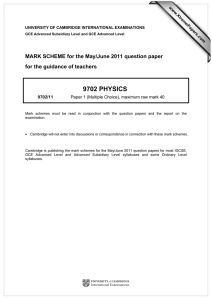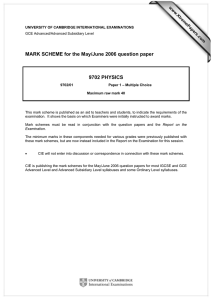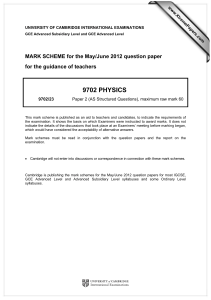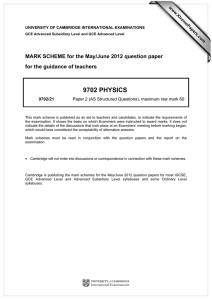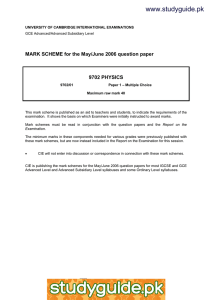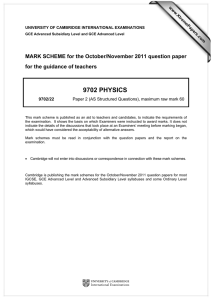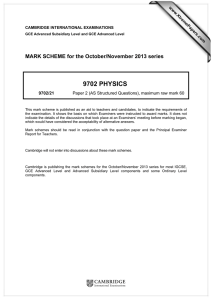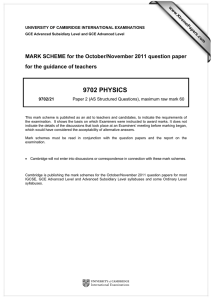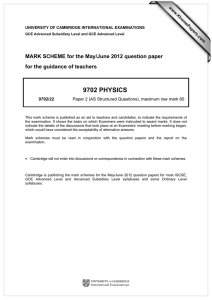Physics Mark Scheme 9702/22 May/June 2011
advertisement
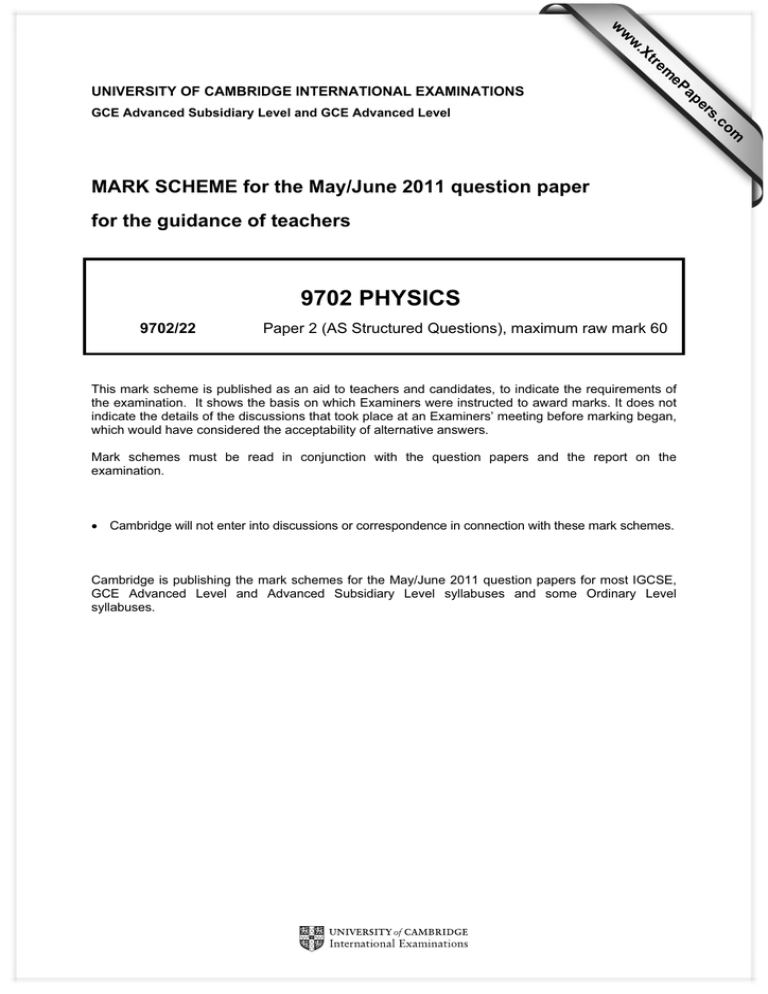
w w ap eP m e tr .X w UNIVERSITY OF CAMBRIDGE INTERNATIONAL EXAMINATIONS for the guidance of teachers 9702 PHYSICS 9702/22 Paper 2 (AS Structured Questions), maximum raw mark 60 This mark scheme is published as an aid to teachers and candidates, to indicate the requirements of the examination. It shows the basis on which Examiners were instructed to award marks. It does not indicate the details of the discussions that took place at an Examiners’ meeting before marking began, which would have considered the acceptability of alternative answers. Mark schemes must be read in conjunction with the question papers and the report on the examination. • Cambridge will not enter into discussions or correspondence in connection with these mark schemes. Cambridge is publishing the mark schemes for the May/June 2011 question papers for most IGCSE, GCE Advanced Level and Advanced Subsidiary Level syllabuses and some Ordinary Level syllabuses. om .c MARK SCHEME for the May/June 2011 question paper s er GCE Advanced Subsidiary Level and GCE Advanced Level Page 2 1 Mark Scheme: Teachers’ version GCE AS/A LEVEL – May/June 2011 Syllabus 9702 Paper 22 (a) scalar has only magnitude vector has magnitude and direction B1 B1 [2] (b) kinetic energy, mass, power all three underlined B1 [1] (c) (i) s = ut + ½ at2 15 = 0.5 × 9.81 × t2 T = 1.7 s C1 A1 [2] C1 C1 A1 [3] if g = 10 is used then –1 but only once on paper (ii) vertical component vv: vv2 = u2 + 2as = 0 + 2 × 9.81 × 15 or vv = u + at = 9.81 × 1.7(5) vv =17.16 resultant velocity: v2 = (17.16)2 + (20)2 v = 26 m s–1 If u = 20 is used instead of u = 0 then 0/3 Allow the solution using: initial (potential energy + kinetic energy) = final kinetic energy (iii) distance is the actual path travelled displacement is the straight line distance between start and finish points (in that direction) / minimum distance 2 (a) (i) base units of D: force: kg m s–2 radius: m velocity: m s–1 2. B1 [2] B1 B1 base units of D: [F / (R × v)] kg m s–2 / (m × m s–1) = kg m–1 s–1 (ii) 1. B1 M1 A0 [3] F = 6π × D × R × v = [6π × 6.6 × 10–4 × 1.5 × 10–3 × 3.7] = 6.9 × 10–5 N A1 [1] mg – F = ma hence a = g – [F / m] m = ρ × V = ρ × 4/3 π R3 = (1.4 × 10–5) a = 9.81 – [6.9 × 10–5] / ρ × 4/3 π × (1.5 × 10–3)3 a = 4.9(3) m s–2 C1 M1 A1 [3] B1 B1 B1 [3] M1 A1 [2] (9.81 – 4.88) (b) (i) a = g at time t = 0 a decreases (as time increases) a goes to zero (ii) Correct shape below original line sketch goes to terminal velocity earlier © University of Cambridge International Examinations 2011 Page 3 3 Mark Scheme: Teachers’ version GCE AS/A LEVEL – May/June 2011 Syllabus 9702 (a) (i) work done equals force × distance moved / displacement in the direction of the force B1 [1] B1 [1] C1 C1 A1 [3] (ii) potential energy = mgh = 600 × 9.81 × 4.1 = 24132 (J) = 24 kJ M1 A1 A0 [2] (iii) work done = 27 – 24 = 3.0 kJ A1 [1] (iv) resistive force = 3000 / 8.2 (distance along slope = 4.1 / sin 30°) = 366 N C1 A1 [2] B1 B1 [2] (ii) power is the rate of doing work / work done per unit time (b) (i) kinetic energy 4 Paper 22 = ½ mv2 = 0.5 × 600 (9.5)2 = 27075 (J) = 27 kJ (a) clamped horizontal wire over pulley or vertical wire attached to ceiling with mass attached details: reference mark on wire with fixed scale alongside (b) measure original length of wire to reference mark with metre ruler / tape measure diameter with micrometer / digital calipers measure initial and final reading (for extension) with metre ruler or other suitable scale measure / record mass or weight used for the extension good physics method: measure diameter in several places / remove load and check wire returns to original length / take several readings with different loads MAX of 4 points (c) determine extension from final and initial readings plot a graph of force against extension determine gradient of graph for F / e calculate area from πd2 / 4 calculate E from E = F l / e A or gradient × l / A MAX of 4 points © University of Cambridge International Examinations 2011 (B1) (B1) (B1) (B1) (B1) B4 [4] (B1) (B1) (B1) (B1) (B1) B4 [4] Page 4 5 Mark Scheme: Teachers’ version GCE AS/A LEVEL – May/June 2011 Syllabus 9702 (a) (i) energy converted from chemical to electrical when charge flows through cell or round complete circuit (ii) (resistance of the cell) causing loss of voltage or energy loss in cell B1 B1 [2] C1 A1 [2] C1 A1 [2] C1 A1 [2] (c) power supplied from cell B is greater than energy lost per second in circuit B1 [1] (a) (i) to produce coherent sources or constant phase difference B1 [1] (b) (i) EB – EA = I (R + rB + rA) 12 – 3 = I (3.3 + 0.1 + 0.2) I = 2.5 A (ii) Power = E × I = 12 × 2.5 = 30 W (iii) P = I2 × R = (2.5)2 × 3 = 22.5 J s–1 6 Paper 22 or P = V2 / R = 92 / 3.6 or P = VI = 9 × 2.5 (ii) 1. 2. 360° / 2π rad allow n × 360° or n × 2π (unit missing –1) 180° / π rad allow (n × 360°) – 180° or (n × 2π) – π B1 B1 [1] [1] (iii) 1. waves overlap / meet (resultant) displacement is sum of displacements of each wave at P crest on trough (OWTTE) B1 B1 B1 [2] [1] C1 C1 A1 [3] 2. (b) λ = ax / D = 2 × 2.3 × 10–3 × 0.25 ×10–3 / 1.8 = 639 nm © University of Cambridge International Examinations 2011
